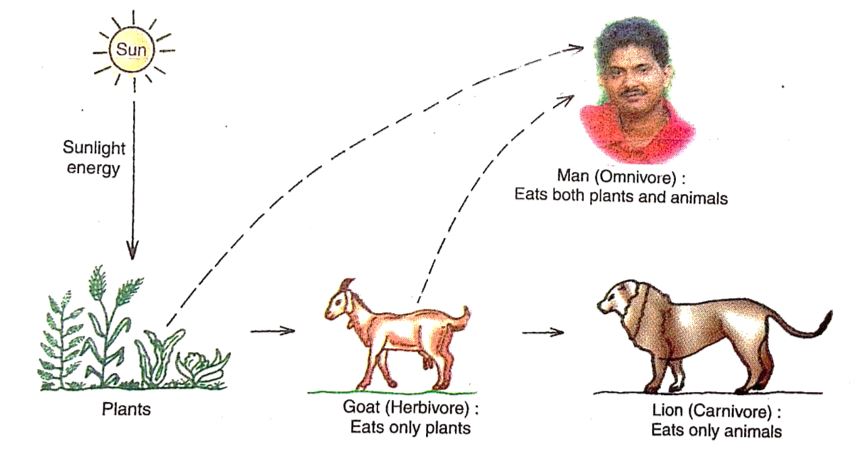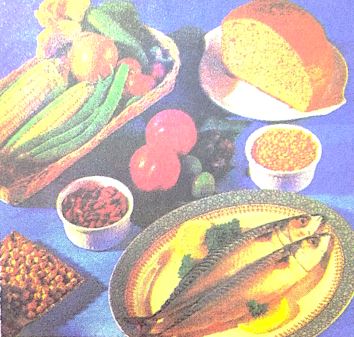We have just studied the nutrition in plants. We have learnt that plants are autotrophic organisms which can manufacture their own food. So, plants don’t have to look to others for getting their food. They are food producers themselves. But this is not so in the case of animals. Animals are heterotrophs and hence they depend on other organisms for their food. Thus, animals need an external source of food. We will now discuss how animals obtain their food.
Animals Obtain their Food from Plants or Other Animals
Contents
- 1 Animals Obtain their Food from Plants or Other Animals
- 2 Different Steps in the Process of Nutrition in Animals
- 3 Nutrition in Simple Animals
- 4 🧬 Nutrition in Animals – Summary
- 5 🐾 Types of Nutrition in Animals
- 6 🍽️ Steps in Animal Nutrition
- 7 🧠 Nutrition in Humans – Digestive System Overview
- 8 🪱 Nutrition in Simple Animals
- 9 📌 Key Points to Remember:
Since animals cannot make their own food, they depend on readymade food. This readymade food comes either from ‘plants’ or from ‘other animals’. Thus, animals obtain their food from plants or other animals (which they eat). We (human beings) are also animals. We obtain the foods like wheat, rice, pulses (dal), fruits and vegetables from plants. And the foods like milk, curd, cheese and eggs are obtained from animals. Some people also eat meat, chicken and fish as food. These foods are also obtained from animals.
Many other animals obtain their food by eating the flesh of other animals. For example, the fish, birds, snakes and insects, all obtain their food from other animals. The big fish eats small fish; the birds eat worms and insects; the snake eats frogs and the insects eat dead bodies of animals. The non-green plants (which cannot make their own food by photosynthesis) also obtain their food from other plants and animals.
Even some of the plants can eat insects. Venus fly-trap plant is one such plant.
Yeast plant is one such example. Even the plants can eat insects. For example, the pitcher plant and the venus fly-trap are the two plants which eat insects.
All the animals can be divided into three groups on the basis of their food habits (or eating habits). These are :
1. Herbivores,
2. Carnivores, and
3. Omnivores.
We will now discuss herbivores, carnivores and omnivores in somewhat detail. Let us start with the herbivores.
1. Herbivores
Some animals eat only plants (or their products). Those animals which eat only plants are called herbivores. The herbivores may eat grasses, leaves, grains, fruits or the bark of trees. Some of the examples of herbivores are: Goat, Cow, Buffalo, Sheep, Horse, Deer, Camel, Ass, Ox, Elephant, Monkey, Squirrel, Rabbit, Grasshopper and Hippopotamus. Cow is called a herbivore because it eats only plants as food. Thus, herbivores are plant eaters. Herbivores are also called herbivorous animals.
Herbivores, carnivores and omnivores.
2. Carnivores
Some animals eat only other animals. They do not eat plant food at all. Those animals which eat only other animals as food are called carnivores. Carnivores eat only the meat (or flesh) of other animals. So, we can also say that: Those animals which eat only the meat (or flesh) of other animals are called carnivores. Some of the examples of carnivores are: Lion, Tiger, Frog, Vulture, Kingfisher, Lizard, Wolf, Snake and Hawk. Lion is called a carnivore because it eats only the meat (or flesh) of other animals like deer, rabbit, goat, etc. Thus, carnivores are meat eaters. Carnivores are also called carnivorous animals.
3. Omnivores
Some animals eat both, plants as well as other animals as food. Those animals which eat both, plants and animals, are called omnivores. In other words, the omnivores eat plant food as well as the meat (or flesh) of other animals. Some of the examples of omnivores are: Man (Human beings), Dog, Crow, Sparrow, Bear, Mynah, and Ant. Man is called an omnivore because he eats the plant food (such as grains, pulses, fruits and vegetables) as well as the meat of animals (such as goat, chicken and fish). Thus, omnivores are plant eaters as well as meat eaters. Omnivores are also called omnivorous animals.
All the living things on earth actually depend on the sun for their food. This has been shown clearly in given below:
Diagram to show how all living things (plants and animals) depend on sun for their food.
Plants use the energy of sun and prepare food by photosynthesis. The plants utilise this food for maintaining their life. These plants and their products) are also eaten up by herbivores and omnivores as food. And the carnivores eat herbivores as food. In this way, it is the energy of the sun which provides food for plants, and animals (herbivores, carnivores and omnivores). In the goat is a herbivore which eats plants; man is an omnivore who eats both, plants and meat of goat; and lion is a carnivore which eats the flesh of goat (The man usually does not get eaten up by lion because he is a very clever fellow !).
An organism either makes its own food from raw materials as green plants do or takes in readymade food as animals do. The process of obtaining food and then using it for obtaining energy, growth and repair of the body, is called nutrition. We will now discuss the animal nutrition in detail.
Different Steps in the Process of Nutrition in Animals
There are five main processes concerned with the use of food by animals. In other words, there are five steps in the process of nutrition in animals. These are: Ingestion, Digestion, Absorption, Assimilation and Egestion. All these steps are discussed below:
1. Ingestion
In order to provide the energy necessary for growth and carry on life’s activities, we must ‘eat food’ or ‘take food into the body’. The process of taking food into the body is called ingestion. In most simple terms, ingestion means ‘eating of food’ by the animal. When we put food into our mouth with hands, we are ingesting (the food).
2. Digestion
The food of most animals consists of large insoluble molecules which cannot be absorbed by the animal’s body in this form. So, before the food can be used by the animal for various functions like getting energy or for growth, it must be broken down into small, water soluble molecules which can be absorbed by the body. The process in which the food containing large, insoluble molecules is broken down into small, water soluble molecules (which can be absorbed by the body) is called digestion. In most simple terms, digestion is the dissolving of the solid food.
Our food contains very big molecules of carbohydrates (like starch), fats and proteins which cannot be absorbed in the body as such. They must be broken down into small, water soluble molecules which can be absorbed by the body. This happens in the process of digestion.
Digestion makes the food soluble so that it can be utilised by the animal’s body. Most animals use both, physical and chemical methods for digesting (breaking up the large food molecules. Physical methods include chewing and grinding the food in mouth and chemical methods include the addition of digestive juices (enzymes) to food by the body itself.
3. Absorption
After digestion, the food molecules become small and soluble. The soluble food molecules can pass through the walls of our intestine and go into blood. The process in which the digested food passes through the intestinal wall into blood stream is called absorption.
4. Assimilation
Blood carries the absorbed food to all the parts of the body. The food then enters each and every cell of the body where it is used for producing energy and for making materials for the growth and repair of the body. The process in which the absorbed food is taken in by body cells and used for energy, growth and repair, is called assimilation.
5. Egestion
The whole food which we eat is not digested by our body. A part of the food which we eat remains undigested (or insoluble) which cannot be used by the body. This undigested part of the food is then removed from the body in the form of faeces when we go to toilet. The process in which the undigested food is removed from the body is called egestion.
Nutrition in Simple Animals
Amoeba and Paramecium are two very simple animals. The body of each one of them consists of a single cell only. They are called unicellular animals. In unicellular animals, all the processes of nutrition are performed by the single cell. This point will become more clear from the following example of the nutrition in Amoeba.
You can write your questions and suggestions to us in the comment box given below.
Thank you
Nutrition in Animals is an important topic in biology, especially for school students (usually covered in Class 7 Science in CBSE/NCERT curriculum). Here’s a clear explanation:
🧬 Nutrition in Animals – Summary
🔹 What is Nutrition?
Nutrition is the process by which living organisms take in food and use it to get energy, grow, and repair the body.
🐾 Types of Nutrition in Animals
-
Heterotrophic Nutrition:
-
Animals cannot prepare their own food (unlike plants).
-
They depend on plants or other animals for food.
-
This is called heterotrophic nutrition.
-
-
Modes of Heterotrophic Nutrition:
-
Herbivores: Eat only plants (e.g., cow, deer).
-
Carnivores: Eat only meat (e.g., lion, tiger).
-
Omnivores: Eat both plants and animals (e.g., humans, bears).
-
🍽️ Steps in Animal Nutrition
There are five main steps involved:
1. Ingestion:
-
The process of taking food into the body.
-
Example: Humans use the mouth.
2. Digestion:
-
Breaking down complex food into simpler, soluble forms.
-
Can be:
-
Mechanical (chewing)
-
Chemical (enzymes breaking down food)
-
3. Absorption:
-
Nutrients from digested food are absorbed into the blood.
4. Assimilation:
-
Absorbed nutrients are used by body cells for energy, growth, and repair.
5. Egestion:
-
Removal of undigested waste from the body (through the anus in humans).
🧠 Nutrition in Humans – Digestive System Overview
Main organs involved:
-
Mouth – Teeth, saliva help in chewing and starting digestion.
-
Esophagus – Pushes food to the stomach.
-
Stomach – Mixes food with digestive juices (acid and enzymes).
-
Small Intestine – Major digestion and nutrient absorption happen here.
-
Large Intestine – Absorbs water, forms feces.
-
Anus – Removes waste.
Accessory organs:
-
Liver – Produces bile to digest fats.
-
Pancreas – Produces enzymes to digest proteins, carbs, and fats.
🪱 Nutrition in Simple Animals
-
Amoeba: Uses pseudopodia to engulf food (phagocytosis).
-
Paramecium: Uses cilia to direct food into its mouth-like opening.
📌 Key Points to Remember:
-
Animals show heterotrophic nutrition.
-
Digestion in humans involves many organs.
-
Simple animals like amoeba use different methods for nutrition.
Let me know if you’d like this content as a PDF, worksheet, or animated diagram, or if you’re preparing for a specific exam!




